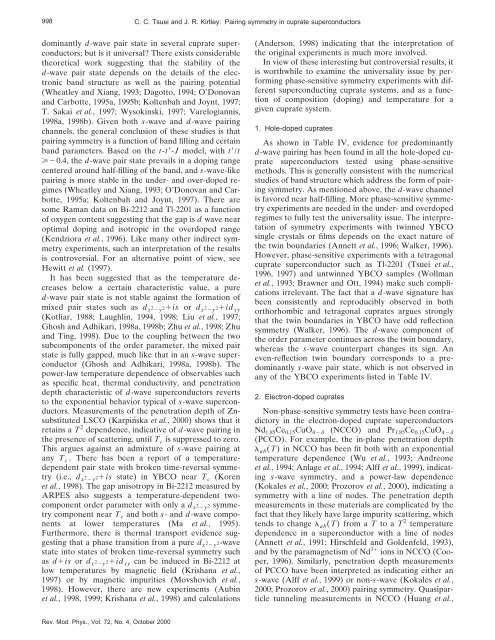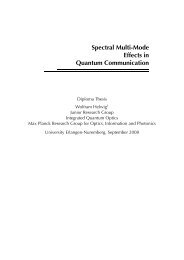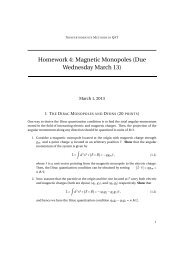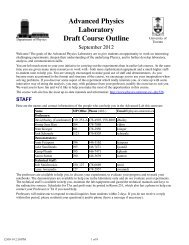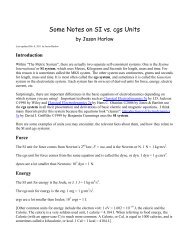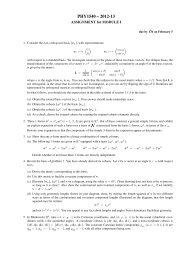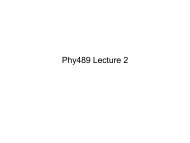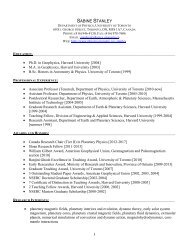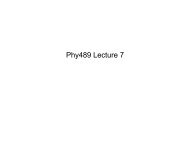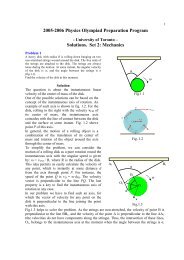Kirtley and Tsuei - Physics
Kirtley and Tsuei - Physics
Kirtley and Tsuei - Physics
You also want an ePaper? Increase the reach of your titles
YUMPU automatically turns print PDFs into web optimized ePapers that Google loves.
998 C. C. <strong>Tsuei</strong> <strong>and</strong> J. R. <strong>Kirtley</strong>: Pairing symmetry in cuprate superconductors<br />
dominantly d-wave pair state in several cuprate superconductors;<br />
but is it universal? There exists considerable<br />
theoretical work suggesting that the stability of the<br />
d-wave pair state depends on the details of the electronic<br />
b<strong>and</strong> structure as well as the pairing potential<br />
(Wheatley <strong>and</strong> Xiang, 1993; Dagotto, 1994; O’Donovan<br />
<strong>and</strong> Carbotte, 1995a, 1995b; Koltenbah <strong>and</strong> Joynt, 1997;<br />
T. Sakai et al., 1997; Wysokinski, 1997; Varelogiannis,<br />
1998a, 1998b). Given both s-wave <strong>and</strong> d-wave pairing<br />
channels, the general conclusion of these studies is that<br />
pairing symmetry is a function of b<strong>and</strong> filling <strong>and</strong> certain<br />
b<strong>and</strong> parameters. Based on the t-t-J model, with t/t<br />
0.4, the d-wave pair state prevails in a doping range<br />
centered around half-filling of the b<strong>and</strong>, <strong>and</strong> s-wave-like<br />
pairing is more stable in the under- <strong>and</strong> over-doped regimes<br />
(Wheatley <strong>and</strong> Xiang, 1993; O’Donovan <strong>and</strong> Carbotte,<br />
1995a; Koltenbah <strong>and</strong> Joyut, 1997). There are<br />
some Raman data on Bi-2212 <strong>and</strong> Tl-2201 as a function<br />
of oxygen content suggesting that the gap is d wave near<br />
optimal doping <strong>and</strong> isotropic in the overdoped range<br />
(Kendziora et al., 1996). Like many other indirect symmetry<br />
experiments, such an interpretation of the results<br />
is controversial. For an alternative point of view, see<br />
Hewitt et al. (1997).<br />
It has been suggested that as the temperature decreases<br />
below a certain characteristic value, a pure<br />
d-wave pair state is not stable against the formation of<br />
mixed pair states such as d x 2 y 2is or d x 2 y 2id xy<br />
(Kotliar, 1988; Laughlin, 1994, 1998; Liu et al., 1997;<br />
Ghosh <strong>and</strong> Adhikari, 1998a, 1998b; Zhu et al., 1998; Zhu<br />
<strong>and</strong> Ting, 1998). Due to the coupling between the two<br />
subcomponents of the order parameter, the mixed pair<br />
state is fully gapped, much like that in an s-wave superconductor<br />
(Ghosh <strong>and</strong> Adhikari, 1998a, 1998b). The<br />
power-law temperature dependence of observables such<br />
as specific heat, thermal conductivity, <strong>and</strong> penetration<br />
depth characteristic of d-wave superconductors reverts<br />
to the exponential behavior typical of s-wave superconductors.<br />
Measurements of the penetration depth of Znsubstituted<br />
LSCO (Karpińska et al., 2000) shows that it<br />
retains a T 2 dependence, indicative of d-wave pairing in<br />
the presence of scattering, until T c is suppressed to zero.<br />
This argues against an admixture of s-wave pairing at<br />
any T c . There has been a report of a temperaturedependent<br />
pair state with broken time-reversal symmetry<br />
(i.e., d x 2 y 2is state) in YBCO near T c (Koren<br />
et al., 1998). The gap anisotropy in Bi-2212 measured by<br />
ARPES also suggests a temperature-dependent twocomponent<br />
order parameter with only a d x 2 y 2 symmetry<br />
component near T c <strong>and</strong> both s- <strong>and</strong> d-wave components<br />
at lower temperatures (Ma et al., 1995).<br />
Furthermore, there is thermal transport evidence suggesting<br />
that a phase transition from a pure d x 2 y 2-wave<br />
state into states of broken time-reversal symmetry such<br />
as dis or d x 2 y 2id xy can be induced in Bi-2212 at<br />
low temperatures by magnetic field (Krishana et al.,<br />
1997) or by magnetic impurities (Movshovich et al.,<br />
1998). However, there are new experiments (Aubin<br />
et al., 1998, 1999; Krishana et al., 1998) <strong>and</strong> calculations<br />
(Anderson, 1998) indicating that the interpretation of<br />
the original experiments is much more involved.<br />
In view of these interesting but controversial results, it<br />
is worthwhile to examine the universality issue by performing<br />
phase-sensitive symmetry experiments with different<br />
superconducting cuprate systems, <strong>and</strong> as a function<br />
of composition (doping) <strong>and</strong> temperature for a<br />
given cuprate system.<br />
1. Hole-doped cuprates<br />
As shown in Table IV, evidence for predominantly<br />
d-wave pairing has been found in all the hole-doped cuprate<br />
superconductors tested using phase-sensitive<br />
methods. This is generally consistent with the numerical<br />
studies of b<strong>and</strong> structure which address the form of pairing<br />
symmetry. As mentioned above, the d-wave channel<br />
is favored near half-filling. More phase-sensitive symmetry<br />
experiments are needed in the under- <strong>and</strong> overdoped<br />
regimes to fully test the universality issue. The interpretation<br />
of symmetry experiments with twinned YBCO<br />
single crystals or films depends on the exact nature of<br />
the twin boundaries (Annett et al., 1996; Walker, 1996).<br />
However, phase-sensitive experiments with a tetragonal<br />
cuprate superconductor such as Tl-2201 (<strong>Tsuei</strong> et al.,<br />
1996, 1997) <strong>and</strong> untwinned YBCO samples (Wollman<br />
et al., 1993; Brawner <strong>and</strong> Ott, 1994) make such complications<br />
irrelevant. The fact that a d-wave signature has<br />
been consistently <strong>and</strong> reproducibly observed in both<br />
orthorhombic <strong>and</strong> tetragonal cuprates argues strongly<br />
that the twin boundaries in YBCO have odd reflection<br />
symmetry (Walker, 1996). The d-wave component of<br />
the order parameter continues across the twin boundary,<br />
whereas the s-wave counterpart changes its sign. An<br />
even-reflection twin boundary corresponds to a predominantly<br />
s-wave pair state, which is not observed in<br />
any of the YBCO experiments listed in Table IV.<br />
2. Electron-doped cuprates<br />
Non-phase-sensitive symmetry tests have been contradictory<br />
in the electron-doped cuprate superconductors<br />
Nd 1.85 Ce 0.15 CuO 4 (NCCO) <strong>and</strong> Pr 1.85 Ce 0.15 CuO 4<br />
(PCCO). For example, the in-plane penetration depth<br />
ab (T) in NCCO has been fit both with an exponential<br />
temperature dependence (Wu et al., 1993; Andreone<br />
et al., 1994; Anlage et al., 1994; Alff et al., 1999), indicating<br />
s-wave symmetry, <strong>and</strong> a power-law dependence<br />
(Kokales et al., 2000; Prozorov et al., 2000), indicating a<br />
symmetry with a line of nodes. The penetration depth<br />
measurements in these materials are complicated by the<br />
fact that they likely have large impurity scattering, which<br />
tends to change ab (T) from a T to a T 2 temperature<br />
dependence in a superconductor with a line of nodes<br />
(Annett et al., 1991; Hirschfeld <strong>and</strong> Goldenfeld, 1993),<br />
<strong>and</strong> by the paramagnetism of Nd 3 ions in NCCO (Cooper,<br />
1996). Similarly, penetration depth measurements<br />
of PCCO have been interpreted as indicating either an<br />
s-wave (Alff et al., 1999) or non-s-wave (Kokales et al.,<br />
2000; Prozorov et al., 2000) pairing symmetry. Quasiparticle<br />
tunneling measurements in NCCO (Huang et al.,<br />
Rev. Mod. Phys., Vol. 72, No. 4, October 2000


